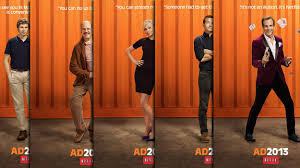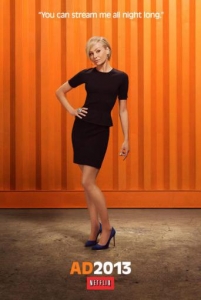As we countdown to Arrested Development’s launch day, May 26, I’m riveted by the potential impact of Netflix’s all-in-one season on the future of storytelling. Key is creator Mitch Hurwitz’s decision to construct the episodes as what one could call, following the experimentations of hypertext and database narratives, a recombinatory narrative system, but with a difference. As Willa Paskin notes in her feature in Wired on March 19th, 2013: “It’s something new—a collection of episodes released altogether that can be remixed and recombined and that gain something from each juxtaposition… Each episode will cover events from a different character’s point of view, like a comedic Rashomon. There will be moments and Easter eggs that will make sense only in retrospect. There will be a suggested viewing sequence, but it will be possible—even rewarding—to watch out of sequence.”
 The more I think about the experimental possibilities of what Sara Thacher calls “‘Web-Native’ TV,” the richer future I see as, while the concept at play may be new for television, this model of spatial, fragmented and shifting narrative is well-established in other media, meaning there is a wealth of knowledge that can be drawn upon for this kind of experimentation. Netflix is now mainstreaming what has existed in film and literature for decades as postmodern subversive play with fragmentation, point of view, narrative in/coherence, and the spatial, distributed, and associative design that underlies much interactive/experimental cinema, and interactive documentaries – iDocs – in particular.
The more I think about the experimental possibilities of what Sara Thacher calls “‘Web-Native’ TV,” the richer future I see as, while the concept at play may be new for television, this model of spatial, fragmented and shifting narrative is well-established in other media, meaning there is a wealth of knowledge that can be drawn upon for this kind of experimentation. Netflix is now mainstreaming what has existed in film and literature for decades as postmodern subversive play with fragmentation, point of view, narrative in/coherence, and the spatial, distributed, and associative design that underlies much interactive/experimental cinema, and interactive documentaries – iDocs – in particular.  What we’re seeing is content design responding to platform and to audience – what Paskin describes as ‘television built be binged’ based on Netflix’s knowledge of audience viewing behaviour Where Hurwitz earlier toyed with the idea of using a ‘choose-your-own-adventure’ model, the exiting recombinatory model creates a new challenge for the audience as the order of episodes you choose will impact on how you view and empathize with characters through given sequences. It’s this effect that has me jumping up and down inside!
What we’re seeing is content design responding to platform and to audience – what Paskin describes as ‘television built be binged’ based on Netflix’s knowledge of audience viewing behaviour Where Hurwitz earlier toyed with the idea of using a ‘choose-your-own-adventure’ model, the exiting recombinatory model creates a new challenge for the audience as the order of episodes you choose will impact on how you view and empathize with characters through given sequences. It’s this effect that has me jumping up and down inside!  Portia de Rossi (Lindsay Bluth Fünke) describes how “I did a scene with Jessica [Walter, who plays Lindsay’s mother], where she seemed to be saying the nastiest things, in my mind, because it was so sarcastic…But in her episode, you realize that she was being sincere. If you see my episode first, u’re like, ‘That fucking bitch.’ But if you see hers first, I look completely heartless.” (Paskin, Wired). What I love about this is the dilemma I am now consciously aware of – which episode will I watch first? How will my construction of a linear viewing sequence impact my understanding of the whole? What are the other variables between different POV episodes? This really is a delicious dilemma as once I’ve chosen I can’t go back & recover my narrative innocence – return to a state of ‘unknown unknowns.’ (Ah…the shadow of Rumsfeld…) Once I watch one, the rubic’s cube of known unknowns will start to take shape as the story map of scenes and interactions is revealed. In the meantime, Arrested Development Season Four looks like it will offer one of the best forms of interactivity, which I started writing about in the context of interactive narrative design watching Nolan’s Memento.Though screened as a linear-viewing experience, the complications of the interwoven time-lines and unstable status of the narrative threads made for a cognitive interaction that was extremely active, as I worked to align and realign story threads & my understanding of character status. Think Barthes’ active engagement with the writerly text now derailing TV’s more often passive medium with Netflix’ disruption of TV’s traditional serial/sequential viewing. With Arrested Development, I’m going to bet that Hurwitz has crafted a viewing experience that will drive fans back for multiple repeat views, binge viewing continued in excess over time with the aim of mentally constructing and reconstructing the narrative whole. I often find that at the end of power viewing a series over a weekend that I’ve lost track of details in the first episodes & I want to rewatch in order to recover narrative coherence. Here too, no doubt, Netflix’s data analytics can provide insights on viewer habits of rewatching fave content in Netflix’s flat fee context. That audience loyalty is about to get rewarded as layers of AD narrative complexity will be presumably revealed in multiple viewings. Let the agonizing hilarity begin.
Portia de Rossi (Lindsay Bluth Fünke) describes how “I did a scene with Jessica [Walter, who plays Lindsay’s mother], where she seemed to be saying the nastiest things, in my mind, because it was so sarcastic…But in her episode, you realize that she was being sincere. If you see my episode first, u’re like, ‘That fucking bitch.’ But if you see hers first, I look completely heartless.” (Paskin, Wired). What I love about this is the dilemma I am now consciously aware of – which episode will I watch first? How will my construction of a linear viewing sequence impact my understanding of the whole? What are the other variables between different POV episodes? This really is a delicious dilemma as once I’ve chosen I can’t go back & recover my narrative innocence – return to a state of ‘unknown unknowns.’ (Ah…the shadow of Rumsfeld…) Once I watch one, the rubic’s cube of known unknowns will start to take shape as the story map of scenes and interactions is revealed. In the meantime, Arrested Development Season Four looks like it will offer one of the best forms of interactivity, which I started writing about in the context of interactive narrative design watching Nolan’s Memento.Though screened as a linear-viewing experience, the complications of the interwoven time-lines and unstable status of the narrative threads made for a cognitive interaction that was extremely active, as I worked to align and realign story threads & my understanding of character status. Think Barthes’ active engagement with the writerly text now derailing TV’s more often passive medium with Netflix’ disruption of TV’s traditional serial/sequential viewing. With Arrested Development, I’m going to bet that Hurwitz has crafted a viewing experience that will drive fans back for multiple repeat views, binge viewing continued in excess over time with the aim of mentally constructing and reconstructing the narrative whole. I often find that at the end of power viewing a series over a weekend that I’ve lost track of details in the first episodes & I want to rewatch in order to recover narrative coherence. Here too, no doubt, Netflix’s data analytics can provide insights on viewer habits of rewatching fave content in Netflix’s flat fee context. That audience loyalty is about to get rewarded as layers of AD narrative complexity will be presumably revealed in multiple viewings. Let the agonizing hilarity begin.  Alyssa Rosenberg also has an excellent post on “Why ‘Arrested Development Really Represents a Breakthrough for Netflix” And Randy Finch has one here: ‘Will Arrested Development on Netflix Make Storytelling News?‘
Alyssa Rosenberg also has an excellent post on “Why ‘Arrested Development Really Represents a Breakthrough for Netflix” And Randy Finch has one here: ‘Will Arrested Development on Netflix Make Storytelling News?‘
